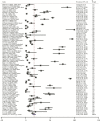Worldwide prevalence of microbial agents' coinfection among COVID-19 patients: A comprehensive updated systematic review and meta-analysis
- PMID: 34851526
- PMCID: PMC8761407
- DOI: 10.1002/jcla.24151
Worldwide prevalence of microbial agents' coinfection among COVID-19 patients: A comprehensive updated systematic review and meta-analysis
Abstract
Background: To provide information about pathogens' coinfection prevalence with SARS-CoV-2 could be a real help to save patients' lives. This study aims to evaluate the pathogens' coinfection prevalence among COVID-19 patients.
Method: In order to find all of the relevant articles, we used systematic search approach. Research-based databases including PubMed, Web of Science, Embase, and Scopus, without language restrictions, were searched to identify the relevant bacterial, fungal, and viral coinfections among COVID-19 cases from December 1, 2019, to August 23, 2021. In order to dig deeper, other scientific repositories such as Medrxiv were probed.
Results: A total of 13,023 studies were found through systematic search. After thorough analysis, only 64 studies with 61,547 patients were included in the study. The most common causative agents of coinfection among COVID-19 patients were bacteria (pooled prevalence: 20.97%; 95% CI: 15.95-26.46; I2 : 99.9%) and less frequent were virus coinfections (pooled prevalence: 12.58%; 95% CI: 7.31-18.96; I2 : 98.7%). The pooled prevalence of fungal coinfections was also 12.60% (95% CI: 7.84-17.36; I2 : 98.3%). Meta-regression analysis showed that the age sample size and WHO geographic region did not influenced heterogeneity.
Conclusion: We identified a high prevalence of pathogenic microorganism coinfection among COVID-19 patients. Because of this rate of coinfection empirical use of antibacterial, antifungal, and antiviral treatment are advisable specifically at the early stage of COVID-19 infection. We also suggest running simultaneously diagnostic tests to identify other microbiological agents' coinfection with SARS-CoV-2.
Keywords: COVID-19; coinfection; coronavirus; meta-analysis; systematic review.
© 2021 The Authors. Journal of Clinical Laboratory Analysis published by Wiley Periodicals LLC.
Conflict of interest statement
The authors report no conflicts of interest in this work.
Figures




Similar articles
-
Bacterial and Fungal Coinfection in Individuals With Coronavirus: A Rapid Review To Support COVID-19 Antimicrobial Prescribing.Clin Infect Dis. 2020 Dec 3;71(9):2459-2468. doi: 10.1093/cid/ciaa530. Clin Infect Dis. 2020. PMID: 32358954 Free PMC article. Review.
-
Viral Coinfection among COVID-19 Patient Groups: An Update Systematic Review and Meta-Analysis.Biomed Res Int. 2021 Sep 3;2021:5313832. doi: 10.1155/2021/5313832. eCollection 2021. Biomed Res Int. 2021. PMID: 34485513 Free PMC article.
-
Prevalence and outcomes of co-infection and superinfection with SARS-CoV-2 and other pathogens: A systematic review and meta-analysis.PLoS One. 2021 May 6;16(5):e0251170. doi: 10.1371/journal.pone.0251170. eCollection 2021. PLoS One. 2021. PMID: 33956882 Free PMC article.
-
Worldwide prevalence of fungal coinfections among COVID-19 patients: a comprehensive systematic review and meta-analysis.Osong Public Health Res Perspect. 2022 Feb;13(1):15-23. doi: 10.24171/j.phrp.2021.0293. Epub 2022 Feb 8. Osong Public Health Res Perspect. 2022. PMID: 35255675 Free PMC article.
-
Prevalence and Clinical Impact of Coinfection in Patients with Coronavirus Disease 2019 in Korea.Viruses. 2022 Feb 21;14(2):446. doi: 10.3390/v14020446. Viruses. 2022. PMID: 35216039 Free PMC article.
Cited by
-
Investigating epidemiological distribution (temporality and intensity) of respiratory pathogens following COVID-19 de-escalation process in Catalonia, September 2016-June 2021: Analysis of regional surveillance data.PLoS One. 2024 Feb 9;19(2):e0285892. doi: 10.1371/journal.pone.0285892. eCollection 2024. PLoS One. 2024. PMID: 38335176 Free PMC article.
-
Co-Infection in COVID-19 Pneumonia: Discussion Continues.Infect Chemother. 2022 Dec;54(4):792-796. doi: 10.3947/ic.2022.0110. Infect Chemother. 2022. PMID: 36596687 Free PMC article.
-
The sensitivity and specificity of COVID-19 rapid anti-gene test in comparison to RT-PCR test as a gold standard test.J Clin Lab Anal. 2023 Feb;37(3):e24844. doi: 10.1002/jcla.24844. Epub 2023 Feb 1. J Clin Lab Anal. 2023. PMID: 36725342 Free PMC article.
-
Respiratory viral co-infections in patients with COVID-19 and associated outcomes: A systematic review and meta-analysis.Rev Med Virol. 2023 Jan;33(1):e2365. doi: 10.1002/rmv.2365. Epub 2022 Jun 10. Rev Med Virol. 2023. PMID: 35686619 Free PMC article.
-
Changing Epidemiology of Respiratory Tract Infection during COVID-19 Pandemic.Antibiotics (Basel). 2022 Feb 25;11(3):315. doi: 10.3390/antibiotics11030315. Antibiotics (Basel). 2022. PMID: 35326778 Free PMC article. Review.
References
Publication types
MeSH terms
LinkOut - more resources
Full Text Sources
Medical
Miscellaneous

